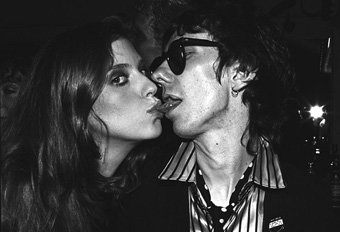Made in L.A.
dal 7/7/2006 al 1/9/2006
Segnalato da
7/7/2006
Made in L.A.
Bamboo Lane Gallery, Los Angeles
Brad Elterman documented a real history of superstars in an impossibly individualized fashion. The Estevan Oriol's photographs oscillate between intimidating street warriors and famous rappers. Norman Scott reveals the anxiety and allegories in the dimmed backstage during the performance of a theatrical play: "The Happy End".

Photography by Brad Elterman, Estevan Oriol and Norman Scott
Sensational, intimate and insightful. Brad Elterman, Estevan Oriol and Norman
Scott's photographs render a Los Angeles that even Los Angelinos hardly have the
access to witness.
Iconographic photographer Brad Elterman's career started with a borrowed
camera at the age of 16. His first photo, of Bob Dylan performing onstage, was
published in 1974. In the 70's and 80's, Elterman documented a real LA history of
superstars in an impossibly individualized fashion. Photos of celebrities can be
dubious when it comes to the realm of fine art, but not so with the work of
Elterman. These pictures are haunting, candid, captivating affairs part Nan Goldin,
part Diane Arbus, and all human.
The magic in his photos lies in the intimacy
reflected between the subjects and Elterman: Madonna is staring right at Elterman
and his camera, while disregarding hundreds of photographers in the same press
room; and Debbie Harry strikes a lethargic pose by a broken chair alone with
Elterman in the backstage of Whisky A Go Go. The stories behind each photo evoke
endless nostalgia for the accelarated years of 70's and 80's in Hollywood.
Having lived in the Hispanic neighborhood of Los Angeles and been closely connected
with renowned musicians and film artists, Estevan Oriol has a unique perspective of
people who form Los Angeles. His photographs oscillate between intimidating street
warriors and famous rappers, sweet Latin girls next door and celebrated actors.
Oriol has a brilliant way of evincing the characters on their own terms in their
own environments.
In all his photos, whether Snoop Dogg posing in front a sign of
"Beware of the dog", or Adrien Brody cruising downtown Los Angeles in a vintage
car, whether vigorous youngsters in South Central or a screaming Japanese man being
tattooed, the subjects and their surroundings enhance each other inseparably. The
result is the resounding visual impact. While providing a stage for the characters
to plot their own narratives, Oriol cleverly creates a substantial distance between
viewers and subjects. He is not even pretending to offer a glimpse of any truth
behind the glamour of public figures or the menace of the street life. The absence
of personal revelation and the inaccessibility are unapologetically appealing,
because myths invite our curiosity.
Responding to Oriol's intensity of the urban culture, another Los Angeles
photographer, Norman Scott's approach to the subjects is equally dramatic, yet more
personal. The son of a talented photographer, Scott inherited his father's passion
and intelligence. Using an infrared digital camera, Scott reveals the anxiety and
allegories in the dimmed backstage during the six weeks of the performance of a
theatrical play: "The Happy End", of which he was also a part of the cast.
The
affect of the series of photos lies significantly in the affection of Scott for the
life in the theater. The intimate distance between the camera and the subjects
betrays a great sense of self-reflection. Every captured second was full of sound
and movement. The subjects in his photos were in a peculiar moment of between two
realities: the reality as common people whom viewers can relate to and the reality
as narrated characters disguised under make-up and costumes. Scott's intentions of
exposing viewers to the sensitivity of life-off-spot-light are vividly conveyed
through his objective manner of shooting and the decisive using of the infrared
camera.
To further reveal the personable notion of the actors in the backstage,
Scott juxtaposes a group of photos of mannequins, shot in a closed department store.
The mannequins were in the similar darkness and with similar artificial outward. The
quietness and motionless of the mannequins tune up the liveliness of the actors.
Opening Reception: Saturday, July 8, 7-10pm
Bamboo Lane Gallery
418 Bamboo Lane, Chinatown Los Angeles, CA
Hours: Wednesday through Saturday, 12-6pm



